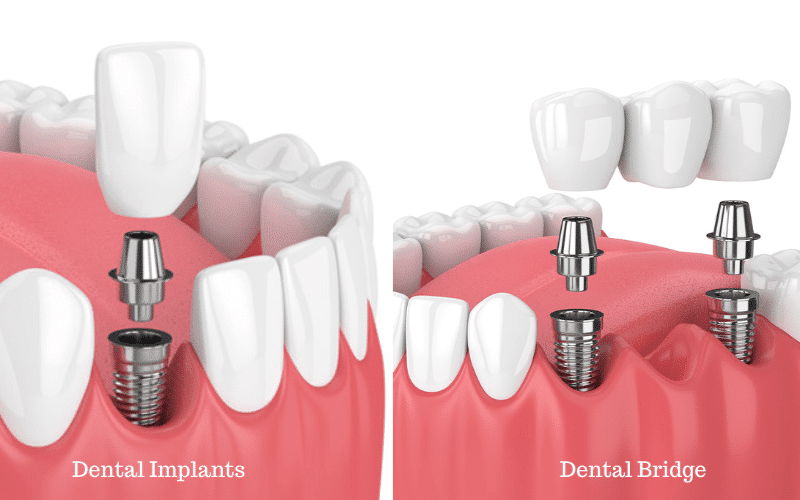
Why Is A Dental Bridge Better Than Dental Implant?
Dental bridges and dental implants are two standard solutions for replacing missing teeth. While both options serve the crucial purpose of restoring functionality and aesthetics, understanding their differences is essential for making an informed decision. Replacing missing teeth is vital for maintaining oral health and improving overall well-being and confidence.This blog aims to compare a dental bridge and an implant, highlighting their benefits and considerations to help individuals choose the most suitable option for their needs. By exploring factors such as stability, aesthetics, maintenance, and cost, readers will gain valuable insights into which option may better suit their unique circumstances.
Understanding Dental Bridges
A dental bridge is a prosthetic device that replaces one or more missing teeth. It consists of a pontic, an artificial tooth that fills the gap left by the missing tooth, and abutments, natural teeth or dental implants on either side of the gap. Dental crowns are placed over the abutment teeth or implants to anchor and stabilize the bridge.
Dental bridges restore functionality and aesthetics by filling gaps, improving chewing ability, maintaining facial structure, and preventing adjacent teeth from shifting. They offer various types to suit different needs, including traditional, cantilever, Maryland, and implant-supported bridges.
Types of dental bridges
1. Traditional Dental Bridge: This type of bridge consists of pontics suspended between two dental crowns placed over the adjacent natural teeth.
2. Cantilever Dental Bridge: This type is similar to traditional bridges but supported by only one abutment tooth instead of two. It is used when there is only one natural tooth next to the gap.
3. Maryland Dental Bridge: A resin-bonded bridge uses a metal or porcelain framework bonded to the back of adjacent natural teeth, with pontics attached to the framework.
4. Implant-Supported Dental Bridge: Instead of being anchored to natural teeth, this bridge is supported by dental implants surgically placed into the jawbone. It provides stability and doesn’t require altering adjacent natural teeth.
These dental bridges offer different advantages and considerations based on factors such as missing teeth, the condition of adjacent teeth, and the patient’s preferences.
Exploring Dental Implants
Dental implants are prosthetic replacements for missing teeth that mimic natural tooth roots. They consist of three main components—the implant, abutment, and crown—and are surgically placed into the jawbone to provide a stable foundation for artificial teeth. The implant acts as the artificial root, fusing with the jawbone over time for optimal stability and support.
The abutment connects the implant to the crown, custom-made to match the surrounding teeth in shape, size, and color. Dental implants offer a long-lasting, durable solution for tooth replacement, providing improved functionality, aesthetics, and oral health benefits.
Different parts of a dental implant
Dental implants consist of three main parts:
1. Implant: The implant is a small, titanium post surgically placed into the jawbone. It is an artificial tooth root, providing a sturdy foundation for the replacement tooth or teeth.
2. Abutment: The abutment is a connector piece that attaches to the top of the implant. It protrudes over the gum line to support the dental crown or bridge. Abutments may be constructed of titanium, gold, or porcelain.
3. Crown or Bridge: The crown or bridge is the visible part of the dental implant that resembles a natural tooth. It is custom-made to match the surrounding teeth’ color, size, and shape for a seamless appearance. Crowns are used to replace a single missing tooth, while bridges are used to replace multiple missing teeth and are supported by implants.
Comparing Dental Bridges and Dental Implants
A. Stability and Durability:
– Dental implants provide improved stability and longevity because they are fixed directly into the jawbone, resembling natural tooth roots.
– Dental bridges rely on adjacent teeth or implants for support, which may compromise their stability over time.
B. Maintenance and Care:
– Dental implants require regular brushing, flossing, and routine dental check-ups, similar to natural teeth.
– Dental bridges necessitate special cleaning techniques, such as floss threaders or interdental brushes, to maintain oral hygiene underneath the bridge.
C. Aesthetic Appearance:
– Dental implants provide a natural and seamless appearance, blending seamlessly with surrounding teeth.
– Dental bridges may have a slightly less natural appearance, especially if the adjacent teeth require significant alterations to support the bridge.
D. Cost Considerations:
– Dental implants typically have a higher initial cost than dental bridges due to the surgical procedure involved.
– Dental bridges may be more cost-effective initially but may require replacement or repair over time, potentially increasing long-term costs.
E. Bone Health Implications:
– Dental implants stimulate jawbone growth and prevent bone loss by replacing the missing tooth root.
– Dental bridges do not address bone loss and may lead to bone resorption over time, potentially affecting facial aesthetics and oral health.
When Is a Dental Bridge a Better Option?
A dental bridge may be a better option in the following scenarios:
1. Adjacent Teeth Condition: When the adjacent teeth are strong and healthy enough to support a bridge without additional dental work.
2. Immediate Replacement: In cases where immediate tooth replacement is desired, dental bridges can be fabricated more quickly than dental implants, which require a healing period after implant placement.
3. Cost Constraints: Dental bridges may be a more affordable option for patients with budget constraints than dental implants, especially if multiple teeth need to be replaced.
4. Minimal Bone Density: If the patient has insufficient bone density or volume in the jawbone to support dental implants, a dental bridge may be a more feasible option.
5. Medical Conditions: In some cases, certain medical conditions or medications may contraindicate dental implant surgery, making a dental bridge a safer alternative.
6. Preference for Non-Surgical Treatment: Patients who prefer to avoid surgery may opt for a dental bridge instead of undergoing the surgical placement of dental implants.
7. Short-Term Solution: When the patient plans to undergo further dental treatments or procedures shortly, a dental bridge may serve as a temporary solution until more permanent options can be explored.
Wrap Up!
In conclusion, while dental bridges and dental implants offer practical solutions for replacing missing teeth, there are specific scenarios where a dental bridge may be a better option. At Singh Smile Care, we understand the importance of personalized care and strive to provide tailored solutions to meet each patient’s unique needs.
Whether due to cost considerations, immediate replacement requirements, or other factors, a dental bridge can offer a practical and efficient solution. Schedule a consultation with Singh Smile Care today to learn more about our dental services and determine which option is best for you. Take the first step towards a healthier, brighter smile!



